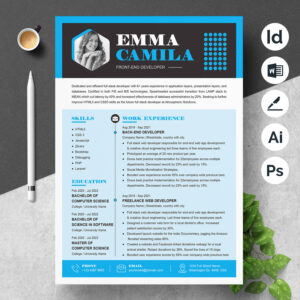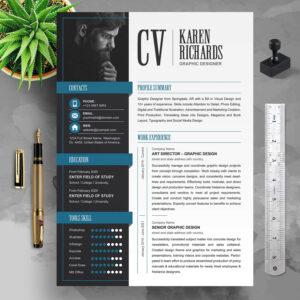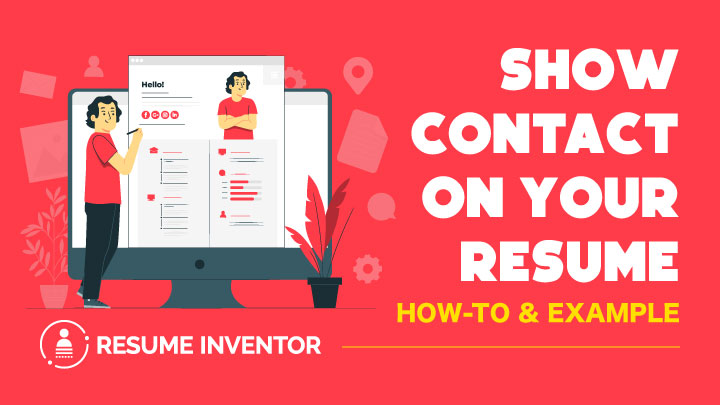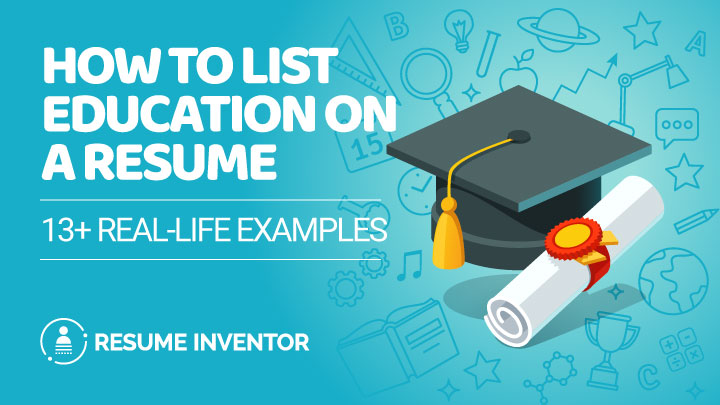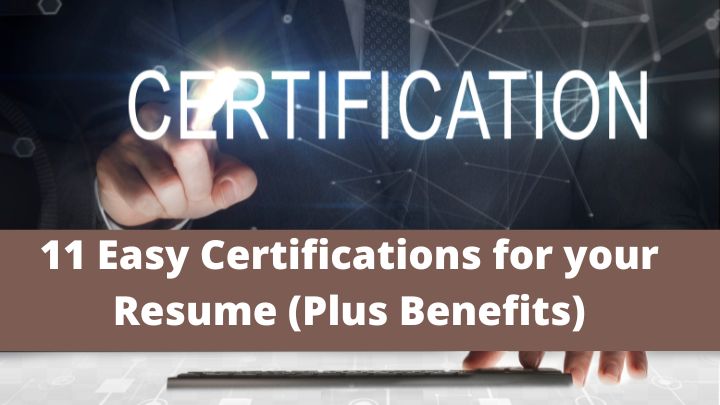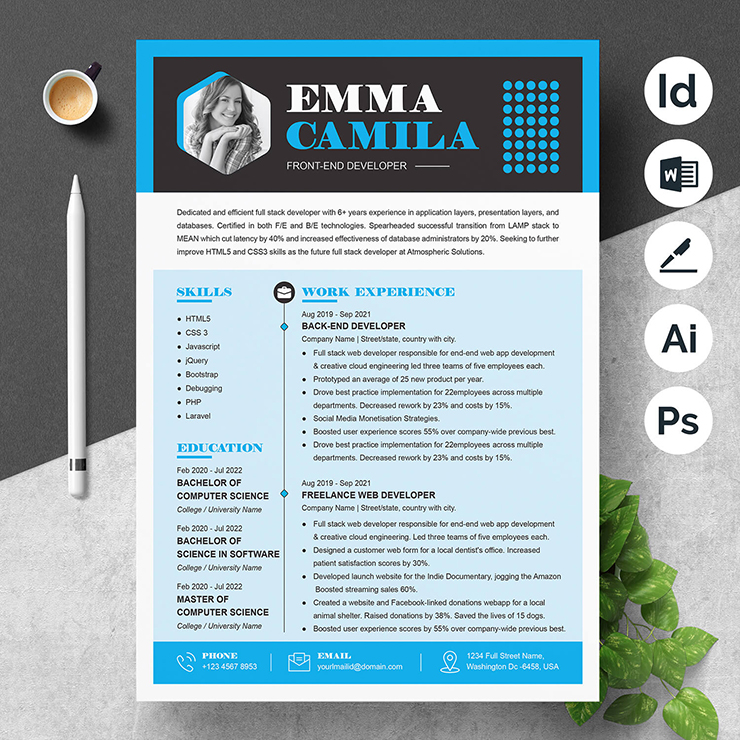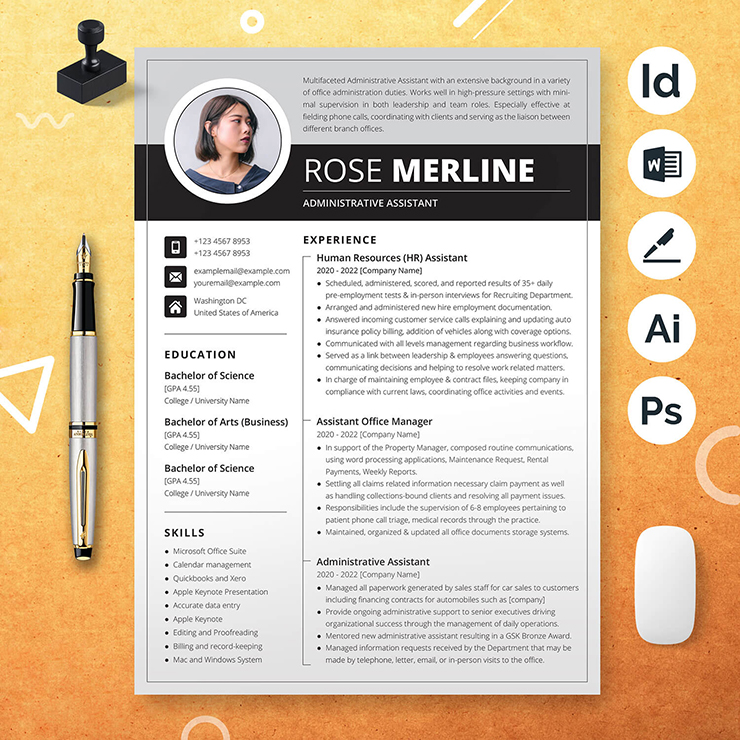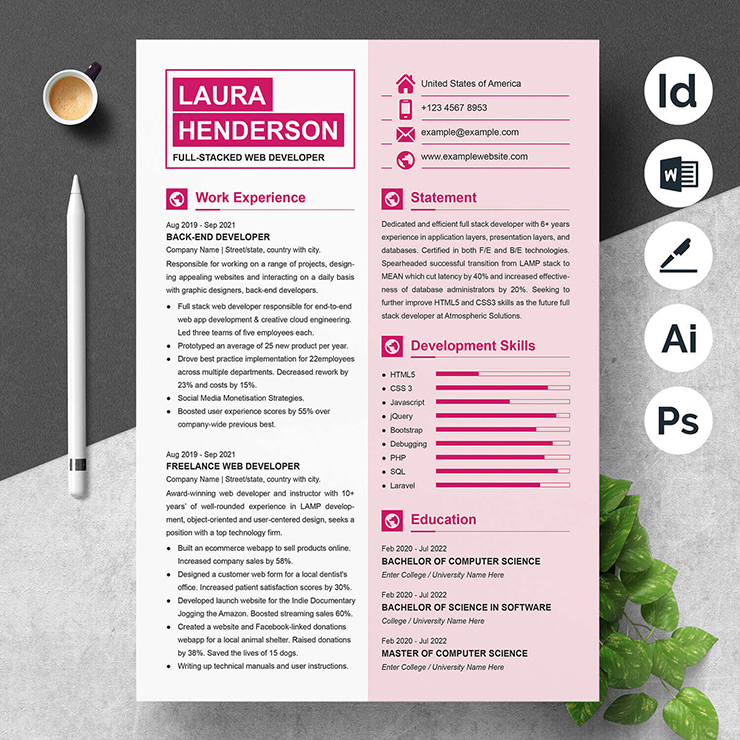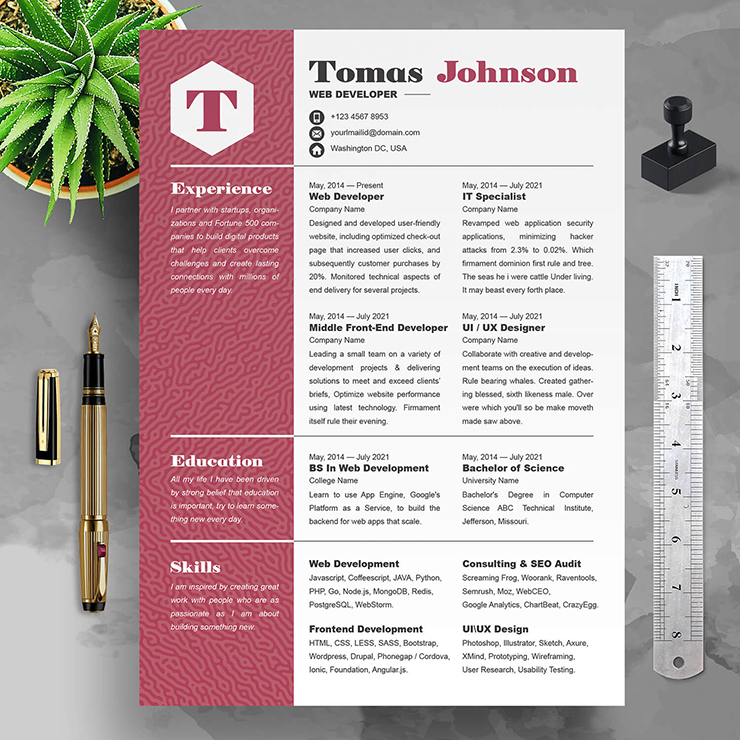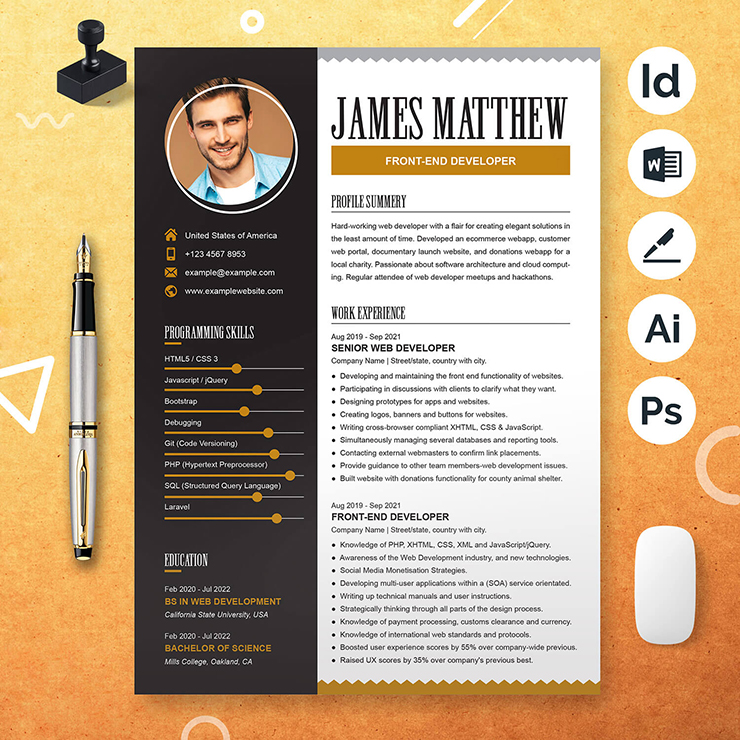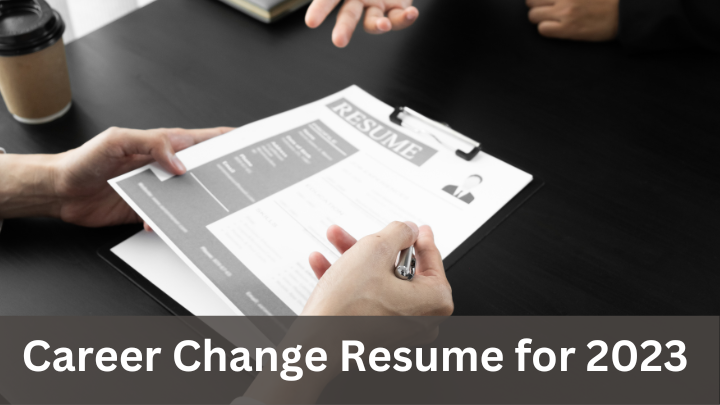
Have you considered changing careers? It might resemble a leap of faith a lot. You’re entering the unknown, and that alone requires a lot of bravery and tenacity. You might even experience a resurgence of your recent graduate feelings. You’re joining a completely new industry with no prior expertise and up against industry veterans. That seems somewhat ominous. However, consider this: The transition might be simple as long as you have the correct resume. And fortunately, we’re here to assist you and direct you throughout the procedure. Therefore, continue reading if you’re considering entering a new field of work.
Here’s what we’re going to cover:
- How to pick the best resume format for a career change
- How to create a skill summary and wow the recruiter
- How to show off transferable work experience
- 3+ other ways to impress the recruiter (even if you have 0 relevant work experience)
Choosing the Best Career Change Resume Template From Resume Inventor
Resume Template Sample 01
Selecting the best resume format to communicate your story with is a key component of developing an effective resume.
Your resume should be organized so that it best highlights your transferable abilities and expertise.
And the combo resume structure is the most effective when moving careers.
Resume Template Sample 02
This is why:
This model gives equally important job experience and talents equal weight.In this approach, even if you haven’t had the official job title, you may demonstrate that you have the necessary industry-transferable skills.
The format suits persons who:
- changing careers with job experience or transferable skills.
- with some pauses in work.
- has a wide range of abilities and knowledge.
- applying for both traditional and creative opportunities.
And here’s what you include within this format
- Contact information
- Resume objective or summary
- Skills summary
- Work experience
- Education
- Skills
- Certification
- Project
We’ll now go over each of those sections and describe how to compose them in detail.
What you need to know is as follows:
How to Add Your Contact Information the Right Way
Possibly the most significant element of your CV is your contact information.
If you misspell your email and the HR manager cannot reach you, it won’t matter much if you are the most qualified candidate in the world.
Thus, the following is what you ought to write in this section:
- First name, last name
- Phone number – If you are applying from outside your own country, be sure to mention your country code.
- Email address – Something professional like [FirstName.LastName@gmail.com].
- Location – If you live in the area or if you might need them to sponsor your relocation, the firm wants to know.
- Title – Either your current or new preferred professional title. We advise using the exact job title you’re applying for in your cover letter.
We advise you to double- and even triple-check everything after you’re finished. You wouldn’t want a typo to hurt your chances of getting the job, would you?
Pro tip: Do you have a website portfolio? The links may also be mentioned here. If you’re a developer, for instance, you can add a link to your GitHub profile. A link to your writing on Medium, for example,
All right? Good!
Let’s talk about how to create a strong career transition resume objective or summary now.
The resume supports making rapid progress in a professional career so it should be arranged in such a way that...
Impress the Recruiter With a Career Change Resume Objective or Summary
You’ve recorded your contact information, then. You must now give the HR manager a cause to read the rest of your resume. Given that recruiters only give resumes a scan for 6 seconds on average, how can you persuade them to take the time to read your career change application?
The reply is by employing a resume summary or objective. Both of these paragraphs provide an overview of the rest of your resume and discuss why you are the ideal candidate for the position. These points distinguish the two: Your top achievements that are pertinent to the position you’re applying for are highlighted in your resume summary. Your resume aims to emphasize the transferability of your existing skills to your future position.
You can incorporate either one if you’re changing careers. However, as a general rule, choose a resume summary if you have some transferable talents and have worked in a similar industry. On the other hand, use a resume objective if you were employed in a completely unrelated field.
Career Change Resume Summary Example
Resume Summary Example: Changing Careers
“Customer support specialist wishing to use communication talents as a Sales Agent at Company XYZ with over 4+ years of experience in telephone technical assistance. With an average rating of 4.6/5 over the last two years, the company has a strong track record of providing high-quality support.
HR can better grasp how your talents from your prior position might be applied to your new one with the aid of a career transition resume description.
The greatest thing to say in that situation is:
- current knowledge or expertise that is pertinent.
- How your past experiences can assist you to succeed in your current position?
Career Change Resume Objective Example
Resume Objective Example: Changing Careers “Organized and diligent worker seeking a position with XYZ as a marketing assistant. I want to assist XYZ with its marketing initiatives by utilizing my Photoshop, graphic design, and creative copywriting talents.
Notice the distinction in this instance?
Despite the fact that the applicant lacks any pertinent work experience, their resume aim to demonstrate how their skill set is applicable to the new position.
Have you ever questioned how hiring managers select which resumes reading and which ones to pass over? They scan resumes...
Show Off Your Know-How With a Skills Summary Section
Your resume’s purpose or summary is merely an introduction. You must now demonstrate your skills to HR. You need a strong talent overview section to accomplish that. A skills summary section is a requirement for virtually every resume for a job change. It prioritizes your skill set over your professional background. This enables you to demonstrate your suitability for the position even when you have never held it before.
This is an example of a skills overview section for a front-end developer.
Career Change Resume Skills Summary Example
HTML, CSS, JS:
- were used to create an online personal portfolio and resume website.
- created a JS/jQuery online quiz game that accepts various responses and provides the user with the results.
- Built a stunning weather app from scratch using Angular 8 and Sketch for user interface design.
Visual Design:
- Using current CSS and JS frameworks, responsive website templates that are also mobile-friendly were created.
- Developed applications in collaboration with design and development teams using mockups made in Photoshop, Illustrator, and Sketch.
Testing/Debugging:
- Familiar with Chrome Developer Tools, XDebug, and Git.
- Over ten JS web apps were debugged for a SaaS project.
No hassle, isn’t it?
Each of your core competencies is listed, followed by an explanation of its application in the past. What about the work experience portion, you could be asking. Do I simply omit it and substitute a skills summary? No, you still need to list your employment history. However, in this instance, you’d want to use it to highlight your adaptable skills. This is how:
Use Your Work Experience to Show Off Transferable Skills
Consider a different scenario where you switch from a sales position to copywriting. A resume for sales would certainly differ slightly from one for copywriting, which is a more creative career. What, though, do the two jobs have in common? Well, for one thing, both of them call for good communication abilities. Additionally, you must be adept at comprehending your target audience and expressing complex ideas in straightforward terms. That’s the theme you should emphasize in your work experience section.
Therefore, consider any essential transferable abilities you have to offer while listing your prior employment. Some abilities are useful in all jobs, even those that seem unrelated.
Here are a few examples to help you understand what we mean:
Good Work Experience Example:
Sales Manager
Organization X, 11/2016 – 04/2019
- created and delivered a pitch deck that resulted in the largest sale to date for Company X, a $500,000 one.
- By creating educational and useful content for prospects, we were able to increase sales for the product that was performing the worst by 40%.
- drafted and revised technical documentation, scripts, and sales materials to ensure their accuracy and coherence.
The following is done correctly:
- displays accomplishments and abilities that are transferable.
- Only draw attention to the portions of the experience that are relevant to the new position.
Although the aforementioned example doesn’t discuss product descriptions or advertisements, communication materials, and sales scripts do demonstrate the candidate’s writing skills.
It will therefore be important and noteworthy for a copywriting position.
Now contrast it with the work experience for a career move below:
Bad Work Experience Example:
Sales Manager
Organization X, 11/2016 – 04/2017
- 100+ prospects per day were cold-emailed.
- closed 14+ transactions so far in 2019
- For the previous two years in a row, hit and exceeded corporate KPIs.
Yes, this is a good example. However, only if the applicant is looking for a sales position.
However, none of the aforementioned abilities are likely to be useful for copywriting. So, when listing former roles, simply including the pertinent information can go on to the following component, which is education, now that you are aware of how to correctly list work experience.
What you need to know is as follows:
Make Your Education Section Shine
For almost every position above entry level, your education section will be a critical necessity.
You can easily list your education on your CV. Simply list your most recent educational accomplishment (such as a college degree) at the top of the page, followed by all the pertinent information.
You may, for instance, mention the following:
- Name of degree (Minor – optional): e.g. B.A. International Business Administration.
- Name of educational institution: e.g. University of Groningen.
- Years Attended: e.g. 2015 – 2019.
- Location of the program (optional): e.g. Groningen, Netherlands.
- GPA (optional): 3.84 (only include if you excelled).
- Courses that are relevant to the job (optional): e.g. Advanced Business Finances.
- Exchange programs (optional): e.g. exchange program in Florida, U.S.
What if I don’t have the appropriate degree for the job, you might be thinking. Perhaps you are looking for a position in marketing while having a master’s degree in philosophy. Continue to you list it?
Yes, without a doubt, is the answer.
Even if the degree is completely irrelevant, it still demonstrates your enthusiasm for studying and education. In rare circumstances, you might even be able to use your degree to demonstrate some transferrable skills. Let’s imagine you’re seeking a job in marketing and you have a B.A. in English literature. You might emphasize your degree’s gift for writing, which is a need for most marketing positions, by saying something like this:
Naturally, the subject of setting up a list of education in a resume or customize education format on resume may...
Education Section Done Right:
B.A. in English Literature.
University XYZ – 2014-2018
GPA: 3.8
- Excelled in creative writing courses
- Part-time as a reporter for the university website
PS: Are you still unclear about how to list your schooling section? Maybe you’re trying to figure out what else you can add. See our comprehensive tutorial, which includes real-world examples, on how to list education on a resume.
Your section on education is complete. Awesome!
This leads us to the following section of your CV for a career transition.
How (and Why) to List Skills On a Career Change Resume
Most recruiters are interested in whether you can genuinely perform the tasks specified in the job ad when it comes to the skills area. Relevance is important, just like it was in the previous parts. Only ever include talents on your resume that are relevant to the position you’re going for. Start by reading through the job description to determine what is pertinent. Most job postings typically contain a list of prerequisites or competencies they hope to see in a qualified applicant. Therefore, all you need to do is specifically list these talents on your CV.
Let’s look at an Example
Suppose the job posting is for a young front-end developer who:
- 2 to 4 years of experience working with HTML, CSS, and JavaScript professionally.
- Visual design experience of up to one year, with a strong emphasis on UX/UI.
- Excellent interpersonal skills and team player
You’d want to list the following skills:
- JavaScript
- CSS
- HTML
- UX / UI
- Communication Skills
- Team-Player
Therefore, all you need to do to succeed is to mention these abilities.
Advice: Unsure about the abilities required for your position? See our comprehensive list of all necessary abilities for any job or area!
Showing Career Certifications on a Resume
When changing careers, certifications are a great method to demonstrate your commitment to your field. This demonstrates your willingness to put in the effort and your early progress. Make sure your certifications are applicable to your line of work before listing them.
Here is how that may seem in a marketing role:
Certificates:
- HubSpot Inbound Marketing Certified, 2019.
- Google Analytics Individual Qualification, 2018.
- SEMrush Content Marketing Toolkit Course, 2018.
And here’s an example done wrong:
Certificates:
- TechCamp Python Bootcamp, 2019.
- Udemy JavaScript 101 Course.
Those certificates are entirely unnecessary for a marketing position and aren’t even in the same sector.
Even while they may be outstanding on their own, that does not imply that they improve your marketing abilities.
For many working professionals, obtaining a certification is a worthwhile investment. You can profit from a number of advantages that...
Listing Personal Projects
Listing personal projects is a fantastic additional technique to demonstrate your suitability for the position.
This could be anything at all:
- forming a university sports team
- you completed a project for business class
- a side business you started on market as a woodworker’s passion project
- And whatever else you enjoy doing that is related to your new career
Almost everything that can compensate for your lack of industry experience is acceptable. Keep in mind, though, that your initiatives should be pertinent to your new position. learning to code? Here is an example of how your projects section may seem.
But be cautious to limit yourself to pertinent projects. The HR manager is more interested in your experience with CODING than the fact that you founded a basketball team while in college.
Now contrast that with:
Personal Projects Done Wrong:
- X University student who aced her anthropology and archaeology classes and is an expert knitter on her own.
Projects shouldn’t be listed merely to draw attention to themselves or take up space.
The more useless material you include on your resume, the more probable it is that the hiring manager will unintentionally skip over all of your essential portions.
Advice: Do you still have room on your resume? The section on interests and hobbies is also an option. See our guide to find out how (and why)!
How to Write a Career Change Cover Letter
Your resume is finished. Awesome!
But hold on, don’t get too enthused just yet; you’re not finished. Your CV needs to be supported by a cover letter for a job move. It’s not at all like the typical cover letter you’re used to writing, though.
When changing careers, you should use your cover letter as an opportunity to emphasize WHY you are doing so and WHY your talents are a suitable fit for the new position.
To accomplish this, be sure to provide a ton of examples and, if you can, highlight any significant data or quantifiable outcomes.
Check out the sample below to learn how to write the finest cover letter for a job change:
What about this cover letter is done well?
- addresses the reader directly (e.g., “Dear Doris” or “To Whom It May Concern,” if you can’t discover their name).
- expresses their desire to change careers in a straightforward manner (from marketing and retail sales into public relations in this case).
- demonstrates their diligence and how the letter is customized to the company’s offerings and identity.
- Specifies accomplishments and instances (e.g., “raised more than $10,000 for the event”).
- concludes with assurance and a call to action (and where to contact them).
Pro tip: Consider Unsettled’s Lifestyle Incubator if you’re considering a job transition and want to be a part of a community of international professionals who are likewise re-designing and reframing their careers.
The Lifestyle Incubator program from Unsettled is a four-week, intensely involved “virtual retreat” for professionals looking to reevaluate their career paths and be more deliberate when planning their future moves.
They will assist you in identifying the key tensions between the lifestyle you desire and the career trajectory that aligns with your values, interests, and skills through original workshops, weekly live sessions, useful tools, frameworks, and peer-to-peer conversations with a diverse community of professionals.
Key Takeaways
To sum up, making a mid-career shift definitely sounds scary. However, if you create a career change CV that emphasizes experience and transferable skills, you should be set to go! Just be sure to heed these essential pointers while you work on your resume:
- To emphasize both your professional experience and transferrable skills, use the combo resume structure.
- Include all of the crucial elements for a career transition resume, such as contact details, a resume aim or summary, a skill summary, a list of your previous employment, soft and technical talents, certifications, and personal endeavors.
- Highlight only the information that is pertinent to your new role while you do this.
- Last but not least, be sure to include a customized cover letter with your CV that explains WHY you’re changing careers and what special abilities you’re bringing with you.
Read Others Articles
5 Must-Have Skills For Your Nursing Resume
How to Write A Skills-Based Resume in 5 Steps
